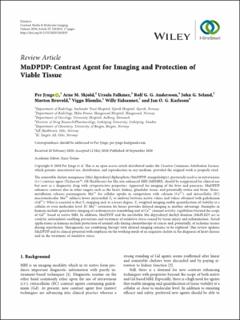| dc.contributor.author | Jynge, Per | |
| dc.contributor.author | Skjold, Arne M. | |
| dc.contributor.author | Falkmer, Ursula | |
| dc.contributor.author | Andersson, Rolf G. G. | |
| dc.contributor.author | Seland, John Georg | |
| dc.contributor.author | Bruvold, Morten | |
| dc.contributor.author | Blomlie, Viggo | |
| dc.contributor.author | Eidsaunet, Willy | |
| dc.contributor.author | Karlsson, Jan O.G. | |
| dc.date.accessioned | 2023-04-14T14:20:14Z | |
| dc.date.available | 2023-04-14T14:20:14Z | |
| dc.date.created | 2020-10-10T11:11:35Z | |
| dc.date.issued | 2020 | |
| dc.identifier.citation | Contrast Media & Molecular Imaging. 2020, 2020:3262385 1-17. | en_US |
| dc.identifier.issn | 1555-4309 | |
| dc.identifier.uri | https://hdl.handle.net/11250/3063202 | |
| dc.description.abstract | The semistable chelate manganese (Mn) dipyridoxyl diphosphate (MnDPDP, mangafodipir), previously used as an intravenous (i.v.) contrast agent (Teslascan™, GE Healthcare) for Mn-ion-enhanced MRI (MEMRI), should be reappraised for clinical use but now as a diagnostic drug with cytoprotective properties. Approved for imaging of the liver and pancreas, MnDPDP enhances contrast also in other targets such as the heart, kidney, glandular tissue, and potentially retina and brain. Transmetallation releases paramagnetic Mn2+ for cellular uptake in competition with calcium (Ca2+), and intracellular (IC) macromolecular Mn2+ adducts lower myocardial T 1 to midway between native values and values obtained with gadolinium (Gd3+). What is essential is that T 1 mapping and, to a lesser degree, T 1 weighted imaging enable quantification of viability at a cellular or even molecular level. IC Mn2+ retention for hours provides delayed imaging as another advantage. Examples in humans include quantitative imaging of cardiomyocyte remodeling and of Ca2+ channel activity, capabilities beyond the scope of Gd3+ based or native MRI. In addition, MnDPDP and the metabolite Mn dipyridoxyl diethyl-diamine (MnPLED) act as catalytic antioxidants enabling prevention and treatment of oxidative stress caused by tissue injury and inflammation. Tested applications in humans include protection of normal cells during chemotherapy of cancer and, potentially, of ischemic tissues during reperfusion. Theragnostic use combining therapy with delayed imaging remains to be explored. This review updates MnDPDP and its clinical potential with emphasis on the working mode of an exquisite chelate in the diagnosis of heart disease and in the treatment of oxidative stress. Copyright © 2020 Per Jynge et al. | en_US |
| dc.language.iso | eng | en_US |
| dc.publisher | Wiley | en_US |
| dc.relation.uri | https://www.ncbi.nlm.nih.gov/pmc/articles/PMC7501573/pdf/CMMI2020-3262835.pdf | |
| dc.rights | Navngivelse 4.0 Internasjonal | * |
| dc.rights.uri | http://creativecommons.org/licenses/by/4.0/deed.no | * |
| dc.subject | Brain / diagnostic imaging* | en_US |
| dc.subject | Brain / metabolism; | en_US |
| dc.subject | Contrast Media / metabolism*; | en_US |
| dc.subject | Heart / physiology* | en_US |
| dc.subject | Edetic acid; | en_US |
| dc.subject | Humans; | en_US |
| dc.subject | Magnetic Resonance Imaging; | en_US |
| dc.subject | Manganese / chemistry*; | en_US |
| dc.subject | Retina / metabolism; | en_US |
| dc.subject | Pyridoxal Phosphate / metabolism; | en_US |
| dc.title | MnDPDP: Contrast agent for imaging and protection of viable tissue | en_US |
| dc.type | Peer reviewed | en_US |
| dc.type | Journal article | en_US |
| dc.description.version | publishedVersion | en_US |
| dc.rights.holder | Copyright © 2020 Per Jynge et al. 'is is an open access article distributed under the Creative Commons Attribution License, which permits unrestricted use, distribution, and reproduction in any medium, provided the original work is properly cited. | en_US |
| dc.source.pagenumber | 1-17 | en_US |
| dc.source.volume | 2020:3262385 | en_US |
| dc.source.journal | Contrast Media & Molecular Imaging | en_US |
| dc.identifier.doi | 10.1155/2020/3262835 | |
| dc.identifier.cristin | 1838617 | |
| cristin.ispublished | true | |
| cristin.fulltext | original | |
| cristin.qualitycode | 1 | |

